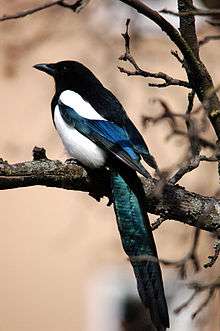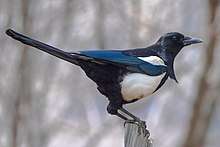Pica (genus)
Pica is the genus of seven species of birds in the family Corvidae in both the New World and the Old.
| Pica | |
|---|---|
 | |
| Eurasian magpie (P. pica) | |
| Scientific classification | |
| Kingdom: | Animalia |
| Phylum: | Chordata |
| Class: | Aves |
| Order: | Passeriformes |
| Family: | Corvidae |
| Genus: | Pica Brisson, 1760 |
| Species | |
The genus Pica was introduced by the French zoologist Mathurin Jacques Brisson in 1760.[1][2] The name was derived by tautonymy from the specific epithet of the Eurasian magpie Corvus pica introduced by Linnaeus in 1758.[2][3] Pica is the Latin word for the Eurasian magpie.[4]
They have long tails and have predominantly black and white markings. One species ranges widely from Europe through Asia, one occurs in western North America, one is restricted to California, one is restricted to southwestern Saudi Arabia, and one occurs across North Africa; the last two are often considered subspecies of the Eurasian. They are usually considered closely related to the blue and green magpies of Asia, but recent research suggests their closest relatives are instead the Eurasian crows.[5]
Two or three species were generally recognized, the yellow-billed and one or two black-billed ones. Recent research has cast doubt on the taxonomy of the Pica magpies.[6] P. hudsonia and P. nuttalli are each other's closest relatives, but may not be different species. If they are, however, at least the Korean race of P. pica would have to be considered a separate species, too.
Taxonomy
Recognized living species include:
| Image | Scientific name | Common Name | Distribution |
|---|---|---|---|
 | Pica pica | Eurasian magpie | Europe and Asia |
.jpg) | Pica serica | Oriental magpie | from southeastern Russia and Myanmar to eastern China, Korea, Japan, Taiwan and northern Indochina |
 |
Pica bottanensis | Black-rumped magpie | central Bhutan, west-central China |
| Pica asirensis | Asir magpie | Asir Region of Saudi Arabia | |
_Magpie%2C_Morocco.jpg) | Pica mauritanica | Maghreb magpie | North Africa |
 | Pica nuttalli | Yellow-billed magpie | California |
.jpg) | Pica hudsonia | Black-billed magpie | western half of North America |
Fossil species
A prehistoric species of Pica, Pica mourerae, is known from fossils found in Pliocene–Pleistocene boundary strata on Mallorca.
Mating systems
Ecology and sexual selection
Magpies of the genus Pica utilize a few indicators of mate quality to optimize breeding success. This leads to sexual selection pressures for the individuals within the genus. Magpies often pair with the same individual through multiple breeding seasons. Change in mates may occur if higher fitness individuals becomes available.[7][8] Males rarely moves between territories. If female mate is lost, males would defend current territory alone until next paring.[9] In contrast females move between territories much more frequent.[10] If females lose their mate, they lose their direct benefits to access of resources. Females do not or are unable to maintain territory if male mate is lost.[11] These females will leave their territory to see new mate in new territory.[11]
One indicator of mate quality is tail size and condition.[8] Larger tail and shapes can have a built-in incur of cost to the individual.[8] Sexually selecting for a mate that has the ability to offset the higher cost of a larger tail, indirectly suggest increased fitness of that particular individual.[12][13] This is thought as a possible form of honest signalling to potential mates.[8][13] This applies to both sexes of Pica pica, which carries similar monomorphic plumage. Thus both sexes can determine the quality of the opposite sex via similar attributes of plumage.[14][15] For magpies, the long graduated tail is also part of plumage color display. Tail display is thought to be used for intersexual competition and intrasexual display in courting.[7] Quality of male tail correlate with quality of the territory.[8] It was shown in a study that tail quality has a high correlation with reproductive success. Magpies that maintained their tail from damage achieved earlier paring in the breeding season, resulting in twice as many offspring compared to magpies which had damaged tails.[8]
For magpies, quality of male correlates with quality of territory.[16] Female reproductive investment correlates with foods rich in protein and territory quality provided by the male.[17] With increased availability of resources, male magpies tends to build larger nests. Females will use both nest size and external environmental resource availability to select for the ideal mate.[17] Nest size is also a direct benefit to the female. Larger nests is able to support larger clutch size.[18] Thus, nest size is used as a sexually selected signal by females, as an honest signal for a willingness of parental investment by the male.[18][19] Furthermore, clutch size invested by the females do not differ with variance in food availability. It is suggested that sexual selection is the main factor when it comes to female magpies' reproductive strategy.[17]
During reproduction, female magpies follow a strategy of differential allocation and/or reproductive compensation.[17] Not only will females estimate the ideal egg clutch size that pair ideally to male quality, but females will adjust laying eggs sooner in the matting season if males were deemed higher quality.[17] Females can also vary the size of eggs to evenly optimize reproductive success, with a given mate quality.[19] Females with higher quality males sometimes trade larger clutch size over larger eggs. The assumption is with good male parental care, small eggs would be offset during hatching stage of their offspring.[17] When food is overly abundant, females will invest heavily in clutch size as well as egg size, leaving no possibly of trade-offs.[17]
Magpies of the genusPica evolved with biparental care.[14][15] Quality of mates largely determines breeding and reproductive success in magpies.[10] Analysis of data in this study suggests 19% of variance in breeding success can be correlated to territory quality that a breeding pair maintains. However, as high as 75% of the variance in reproductive success can be correlated to measurable mate quality parameters. The resulting reproductive success can be, but is not limited to, egg size, clutch size, hatch rate, and fledgling rate.[10] This results in a combination of parental investment and parental care.[10] Female fitness tends to be the main factor that determines clutch size. The physical size of the female is one of the highest correlated factors that determines egg size.[10] Of the females, each individual can chooce to invest more resources into large eggs.[19] Male parental investment becomes the dominant factor once the eggs enters the incubation period.[10] Male magpies provide for the females by giving almost all her food and nourishment during the incubation period.[14] There are two benefits to the breeding pair. First, the pairs’ eggs will have lower chance of predation as the female magpie does not need to leave the nest to obtain nourishment. Second, this also results in consistent incubation of the eggs.[20] The ability of male parental care can also be a direct benefit to the female.[10] Once the eggs have hatched, from the hatchling stage till the one-year fledgling stage, male magpies continuously provided nourishment to the offspring.[10] Studies also suggest male magpies also bring more food to the hatchlings than female magpies.[14] The male expends more energy than the female in the feeding of hatched young.[10]
References
- Brisson, Mathurin Jacques (1760). Ornithologie, ou, Méthode contenant la division des oiseaux en ordres, sections, genres, especes & leurs variétés (in French and Latin). Volume 1. Paris: Jean-Baptiste Bauche. p. 30.
- Mayr, Ernst; Greenway, James C. Jr, eds. (1962). Check-list of birds of the world. Volume 15. Cambridge, Massachusetts: Museum of Comparative Zoology. p. 250.
- Linnaeus, C. (1758). Systema Naturæ per regna tria naturae, secundum classes, ordines, genera, species, cum characteribus, differentiis, synonymis, locis, Volume 1 (in Latin) (10th ed.). Holmiae:Laurentii Salvii. p. 106.
- Jobling, James A (2010). The Helm Dictionary of Scientific Bird Names. London: Christopher Helm. p. 305. ISBN 978-1-4081-2501-4.
- Ericson, Per G. P.; Jansén, Anna-Lee; Johansson, Ulf S.; Ekman, Jan (2005). "Inter-generic relationships of the crows, jays, magpies and allied groups (Aves: Corvidae) based on nucleotide sequence data" (PDF). Journal of Avian Biology. 36: 222–234. doi:10.1111/j.0908-8857.2001.03409.x.
- Lee, Sang-im; Parr, Cynthia S.; Hwang, Youna; Mindell, David P.; Choea, Jae C. (2003). "Phylogeny of magpies (genus Pica) inferred from mtDNA data" (PDF). Molecular Phylogenetics and Evolution. 29: 250–257. doi:10.1016/S1055-7903(03)00096-4. PMID 13678680.
- Cramps, S; Perrins, C. M. (1994). The birds of the Western Palearctic, vol 8. Oxford: Oxford University Press.
- Fitzpatrick, Susan; Price, Peter (1997-03-01). "Magpies' tails: damage as an indicator of quality". Behavioral Ecology and Sociobiology. 40 (3): 209–212. doi:10.1007/s002650050334. ISSN 0340-5443.
- Birkhead, T.R.; Eden, S.F.; Clarkson, K.; Goodburn, S.F.; Pellatt, J. (1986). "Social organisation of a population of Magpies Pica pica". Ardea. 74: 59–68.
- GOODBURN, S. F. (1991-01-01). "Territory quality or bird quality? Factors determining breeding success in the Magpie Pica pica". Ibis. 133 (1): 85–90. doi:10.1111/j.1474-919x.1991.tb04815.x. ISSN 1474-919X.
- Birkhead, T. R.; Clarkson, K. (1985-01-01). "Ceremonial Gatherings of the Magpie Pica Pica: Territory Probing and Acquisition". Behaviour. 94 (3): 324–332. doi:10.1163/156853985x00244. ISSN 1568-539X.
- Grafen, Alan (1990). "Sexual selection unhandicapped by the fisher process". Journal of Theoretical Biology. 144 (4): 473–516. doi:10.1016/s0022-5193(05)80087-6. PMID 2402152.
- JOHNSTONE, RUFUS A. (1995-02-01). "Sexual Selection, Honest Advertisement and the Handicap Principle: Reviewing the Evidence". Biological Reviews. 70 (1): 1–65. doi:10.1111/j.1469-185x.1995.tb01439.x. ISSN 1469-185X. PMID 7718697.
- Buitron, Deborah (1988). "Female and Male Specialization in Parental Care and Its Consequences in Black-Billed Magpies". The Condor. 90 (1): 29–39. doi:10.2307/1368429. JSTOR 1368429.
- Dunn, Peter O.; Hannon, Susan J. (1989). "Evidence for Obligate Male Parental Care in Black-Billed Magpies". The Auk. 106 (4): 635–644. JSTOR 4087668.
- Baeyens, G (1981-01-01). "Functional aspects of serial monogamy: the magpie pair-bond in relation to its territorial system". 69: 125–139. Cite journal requires
|journal=(help) - De Neve, Liesbeth; Soler, Juan J.; Soler, Manuel; Pérez-Contreras, Tomás; Martín-Vivaldi, Manuel; Martínez, Juan G. (2004-05-01). "Effects of a food supplementation experiment on reproductive investment and a post-mating sexually selected trait in magpiesPica pica". Journal of Avian Biology. 35 (3): 246–251. CiteSeerX 10.1.1.384.3073. doi:10.1111/j.0908-8857.2004.03162.x. ISSN 1600-048X.
- Soler, Juan José; Neve, Liesbeth de; Martínez, Juan Gabriel; Soler, Manuel (2001-05-01). "Nest size affects clutch size and the start of incubation in magpies: an experimental study". Behavioral Ecology. 12 (3): 301–307. doi:10.1093/beheco/12.3.301. ISSN 1045-2249.
- de Neve, Liesbeth; Soler, Juan José (2002). "Nest-building activity and laying date influence female reproductive investment in magpies: an experimental study". Animal Behaviour. 63 (5): 975–980. doi:10.1006/anbe.2001.1989.
- Lyon, Bruce E.; Montgomerie, Robert D. (1985-08-01). "Incubation feeding in snow buntings: female manipulation or indirect male parental care?". Behavioral Ecology and Sociobiology. 17 (3): 279–284. CiteSeerX 10.1.1.485.4579. doi:10.1007/bf00300147. ISSN 0340-5443.
Further reading
- Song, S.; Zhang, R.; Alström, P.; Irestedt, M.; Cai, T.; Qu, Y.; Ericson, P.G.P.; Fjeldså, J.; Lei, F. (2017). "Complete taxon sampling of the avian genus Pica (magpies) reveals ancient relictual populations and synchronous Late-Pleistocene demographic expansion across the Northern Hemisphere". Journal of Avian Biology. 49 (2): jav–01612. doi:10.1111/jav.01612.
| Wikispecies has information related to Pica |